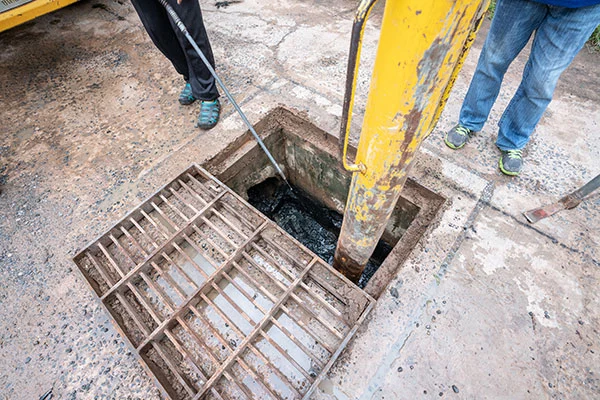Private Drains: Function and Typical Location
Your private drain collects wastewater from toilets, sinks, and showers, then directs it to a lateral drain or soakaway outside your boundary. It usually runs from the internal soil stack to the property line, often buried beneath concrete or landscaping. Clear access to inspection chambers is crucial for spotting leaks or obstructions early.
Owner Responsibility for Private Drains
As a property owner, you are responsible for every part of the private drain within your boundary, including inspection chambers and soakaways. Failure to maintain it can cause damage and legal issues. Landlords have the same obligations for rentals.
Proactive maintenance protects your investment and safeguards tenants by preventing unsanitary conditions and costly call-outs.
Common Issues Affecting Private Drains
- Blockages from the buildup of grease, debris, and hair.
- Tree roots are intruding into the pipe joints.
- Cracks or fractures caused by ground movement or heavy loads.
- Sections of pipe are collapsing due to age and material degradation.
What Is a Lateral Drain? Definition, Ownership, and Common Problems in London
A lateral drain links your private drain at the property boundary to the public sewer. It transfers wastewater safely and helps prevent localised flooding. You'll usually find it beneath verges, footpaths, or carriageways, carrying effluent from a single property to the main sewer.
Since the Private Sewers Transfer Regulations (2011), most lateral drains in England and Wales are owned and maintained by local water companies, so if it runs under your garden wall, it’s their responsibility, not yours.
Lateral Drains: Connection to the Public Sewer
The lateral drain typically connects to your private drain at an inspection chamber on your boundary, then runs under public land to the main sewer. This design keeps foul and surface water separate and helps isolate faults to either the private or public section, reducing the need for extensive digging.
Lateral Drain Responsibility After the 2011 Transfer
Following the 2011 regulations, water and sewerage companies took over ownership and maintenance of adopted lateral drains. Property owners are no longer liable for repairs beyond the boundary. You remain responsible for the private section up to the inspection chamber; issues beyond that point fall to your local water utility.
Environ Drainage Services for Lateral Drain Issues
Our engineers use advanced CCTV surveys to diagnose lateral drain faults, pinpointing blockages and structural damage. We employ high-pressure water jetting to clear roots and scale, and cured-in-place lining to restore integrity without disruptive digging, with same-day London-wide service and 24/7 emergency response.
What Is a Sewer? An Explanation of the Public Sewer System, Ownership, and Maintenance
A public sewer is a network of pipes beneath roads and public land that collects wastewater from many properties and transports it to treatment for safe disposal. Systems often rely on gravity, with pumping stations where needed.
Their core function is to prevent pollution by conveying sewage safely. For instance, the main sewer on your street collects effluent from many lateral drains before reaching a treatment plant. Consistent maintenance by water companies helps ensure capacity, prevent surcharges, and protect public health.
Public Sewer Network: How Wastewater Is Collected
The network uses branch lines that merge into larger trunk mains, directing wastewater downhill to treatment works. Junction chambers provide access for inspection and cleaning, while overflow chambers manage peak flows. This organised hierarchy balances loads and helps prevent localised flooding.
Ownership and Maintenance of Public Sewers in the UK
In the UK, water and sewerage companies regulated by Ofwat own and maintain public sewers, including manholes, pumping stations, and treatment facilities. They have legal access for inspections, emergency repairs, and upgrades, with costs typically covered through customer charges.
Common Public Sewer Problems and Consequences
- Fatbergs form from congealed fats, oils, grease, and non-flushable items like wet wipes.
- Pipe collapses from corrosion or ground movement.
- Root infiltration can damage pipes.
- Blockages often occur at bends or junctions.
London’s fatbergs illustrate the challenges water companies like Thames Water face in managing an extensive network.
How Does Drainage Responsibility Work in the UK? Understanding Who Pays for What
Drainage responsibility hinges on your property boundary and the 2011 regulations. Clear rules help avoid disputes, speed emergency responses, and prevent unexpected costs. For example, knowing that lateral drains fall to the water company can save you the cost and hassle of unnecessary excavation.
2011 Private Sewers Transfer Regulations: Impact
The 2011 Regulations transferred most private sewers and lateral drains connected to public networks into water company ownership. This moved liability for external faults away from individual owners, streamlined maintenance funding, and reinforced regulatory standards for utilities.
Identifying Responsibility Boundaries: Owners vs Water Companies
Responsibility typically lies at the downstream edge of the private drain’s inspection chamber on the property boundary. Owners are responsible up to this chamber; the water company covers everything beyond. Consulting utility records and mapping chambers can confirm the exact limits.
Shared Drain Responsibilities and Management
When lateral drains serve multiple properties, they are usually adopted by the water company. Private sections upstream of the adopted point remain the joint responsibility of connected owners. Formal maintenance agreements or drainage easements can govern cost-sharing and access rights among neighbours.
Saving Money and Preventing Delays Through Clear Responsibility
Accurately identifying liability ensures the right party handles repairs. This prevents unnecessary private excavation costs or emergency call-out charges. Engaging Environ Drainage Services’ engineers for a CCTV survey can define ownership boundaries and ensure invoices go to the appropriate authority.
Drainage Component | Location | Responsibility | Typical Problem
Component | Location | Responsibility | Typical Problem |
|---|
Private Drain | Within the property boundary | Property owner | Blockages, leaks, root ingress |
Lateral Drain | Outside boundary, under public land | Water company (since 2011) | Displaced pipe, corrosion, intrusive roots |
Public Sewer | Under roads and public spaces | Water company | Fatbergs, collapses, surcharge events |
Understanding these key distinctions empowers property owners to take the right action and avoid unnecessary repair expenses.
How to Diagnose Issues with Drains, Lateral Drains, and Sewers: The Essential Role of CCTV Drain Surveys
A CCTV drain survey utilises high-resolution cameras to inspect your pipework, revealing blockages, cracks, and root intrusion without disruptive excavation. This technology guides precise repairs, speeds restoration, and avoids unnecessary digging. For example, a survey may pinpoint a collapsed joint beneath your driveway, allowing a minimal-dig solution.











